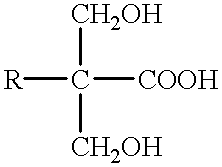Method for the preparation of a multilayer coating and aqueous coating material suitable for this
a multi-layer coating and aqueous coating technology, applied in the direction of coatings, liquid surface applicators, polyurea/polyurethane coatings, etc., can solve the problems of not being able to combine all the desired properties optimally in one vehicle, difficult to solve, etc., to achieve excellent water resistance of coatings, excellent stone chipping resistance, and improved bronze orientation of metallic lacquers
- Summary
- Abstract
- Description
- Claims
- Application Information
AI Technical Summary
Benefits of technology
Problems solved by technology
Method used
Image
Examples
example 1
Preparation of a Metallic Base Lacquer
The acrylated polyurethane dispersion (269 g), named in Preparation Example B, is provided with 5 g of N-methylmorpholine and 79 g of butoxyethanol with stirring. Subsequently, 322 g of a 3% conventional commercial thickener solution based on a polyacrylate dispersion is added with stirring and adjusted with N-methylmorpholine to a pH between 7.3 and 7.6.
Parallel to this, 40 g of a conventional commercial aluminum bronze with an aluminum content of 65% is made into a paste with a mixture of 10 g water, 10 g butoxyethanol, 15 g of a conventional commercial HMM melamine resin and 75 g of the neutralized paste resin described in the preparation example. Subsequently, it is allowed to flow with stirring into the above-described vehicle solution. Subsequently, while stirring (approximately 800 rpm) 175 g of water is added slowly. Finally the viscosity is adjusted with water to a value suitable for spraying, namely 30 seconds according to DIN 53211.
example 2
Preparation of a Tinted Paste
The neutralized paste resin (498 g ), described in the preparation example and diluted with water to a solids content of 27%, is adjusted with N-methylmorpholine to a pH of 7.6 to 8.0 and predispersed for 15 minutes in the dissolver, at 21 m / sec with 50 g of an inorganic black pigment (carbon black), 337 g fully deionized water and 9 g of N-methylmorpholin. Subsequently, it is milled for 90 minutes in a bead mill at temperatures of about 60.degree. C. The milled material finally is finished with 96 g of water. This pigment paste has a high transparency and is outstandingly suitable for tinting water-dilutable metallic and plain base lacquers
example 3
Preparation of a Black Plain Base Lacquer
To the acrylated polyurethane dispersion (410 g), named in Preparation Example B, 6.7 g of N-methylmorpholine and subsequently 364 g of a 3% conventional commercial polyacrylate-based thickener solution are added with stirring. After stirring for 15 minutes, 208 9 of the black tinted paste described in Example 2 and 52 g of butoxyethanol are added. Finally, using water, the viscosity is adjusted to a spraying value of 30 seconds according to DIN 53211.
PUM
| Property | Measurement | Unit |
|---|---|---|
| Fraction | aaaaa | aaaaa |
| Fraction | aaaaa | aaaaa |
| Fraction | aaaaa | aaaaa |
Abstract
Description
Claims
Application Information
 Login to View More
Login to View More - R&D
- Intellectual Property
- Life Sciences
- Materials
- Tech Scout
- Unparalleled Data Quality
- Higher Quality Content
- 60% Fewer Hallucinations
Browse by: Latest US Patents, China's latest patents, Technical Efficacy Thesaurus, Application Domain, Technology Topic, Popular Technical Reports.
© 2025 PatSnap. All rights reserved.Legal|Privacy policy|Modern Slavery Act Transparency Statement|Sitemap|About US| Contact US: help@patsnap.com


